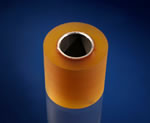Polyurethane
History and formulation
One calls urethane, or commonly "carbamate", any compound produced by the reaction of an isocyanate and an alcohol in accordance with the following reaction:
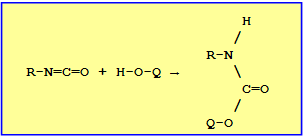
This reaction had been known for several decades when in 1937, Otto Bayer discovered how to make a plastic usable, free from polyisocyanate and polyol. Technologies of urethane were brought to the United States in 1953 by Jean-Pierre Abbat and Fritz Hartmann.
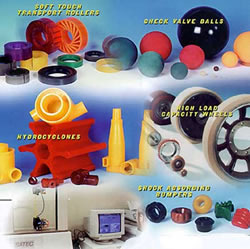
Polyurethanes can be manufactured with a large variety of textures and hardness's by varying the monomers used and by adding other substances.
They are used for the adhesives, paintings, elastomers ("rubber"), foams, fibres. Thus, these plastics with the vast applications are used in a great number of industries.
In the years 1970, the use of urethane for the wheels revolutionized the sports on casters (roller skate, board with casters).
Polyurethane material is characterised by outstanding characteristics, which make it interesting for a large range of applications:
- excellent mechanical wear resistance
- high rebound resilience, even in hard grades
- good tear propagation resistance
- low compression set
- good stability against mineral oils, greases, gasoline and different solvents
More information about polyurethane (104kB)
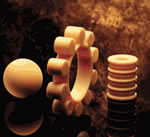 Abrasion resistance:
Abrasion resistance:
The most known property of PU is its abrasion resistance. According to standard tests, the abrasion resistance of polyurethanes is about two and a half to five times higher than for many rubber raw materials and about three to four times higher than that of soft PVC. The differences in the field are frequently even greater, since the excellent damping and impact resilience of polyurethane does not come into play with the standard test methods.
Low temperature flexibility:
Polyurethane becomes increasingly harder with lower temperature, but in contrast to many other plastics, it does not become brittle. Thus the polyurethanes withstood the notched bar impact test even at -30°C without breaking. The long molecular chains (high molecular weights) of the raw materials give significantly better flexibility at low temperatures
Fire behaviour:
(The following information does not apply to electrically conductive, antistatic and flame-resistant types.) Like all organic materials, polyurethane is combustible. The toxicity of the combustion gases and smoke density are usually measured according to DIN 53436. Judged on the basis of this leading international standard, the potential release of hazardous substances (acute inhalation toxicity) at 800°c is no worse than that of natural products such as wood, wool or leather.
Chemical resistance
General information concerning the chemical resistance of PU (133kB)
Our PU range is composed of 2 principal types of polyurethane added with some types reserved for quite particular fields
- Erlan
- Vulkollan
 |  |  |
The ERLAN quality is very interesting because it combines design features which can give excellent results in much applications as well as a report/ratio advantageous price quality.
Vulkollan is based on polyol and naphthylene-1,5-diisocyanate (Desmodur® 15)
Vulkollan is a polyurethane produced by polyaddition with the exclusive use of:
- Desmodur® 15
- Polyol
- And a cross-linking agent
The product forms of Vulkollan
Vulkollan is available in three primary forms:
- Solid, glycol-cross-linked cast Vulkollan
Glycol cross linked PU Datasheet (152kB)
- Solid, water-cross-linked pressed Vulkollan
Water cross linked PU Datasheet (125kB)
- Cellular, water-cross-linked foamed Vulkollan
Hardness range
Vulkollan fills the gap in hardness range between rubber/elastic material and hard plastics (e.g. polyamide). Its hardness ranges from 65° Shore A to 70° Shore D
Cellular Vulkollan is manufactured in a density from 350 to 650 Kg/m³
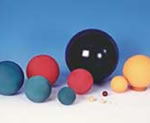 | 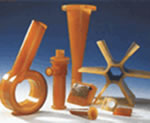 | 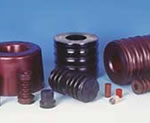 |
Applications areas
Because of its outstanding mechanical properties, Vulkollan is employed throughout the industrial sector where high demands are required for such materials.
Parts with varying weights, , ranging from a few grams to more than 100 kg per piece, are economically produced in large series as well as in one time production pieces.
Production capabilities
- Technically moulded parts from drawings or samples
- Vulkollan to metal bonding (e.g. covered wheels)
- Balls (with or without metal cores)Vu
- Sleeves, gaskets
- sheets, strips,
- tubes, rods
- profiles
For the solution of customized problems beyond that modified PU casting systems stand for order, for e.g.
- hydrolysis stability: Polyether PU (water environments) Datasheet (118kB)
- microbe-resistant : Polyether PU (FDA approved) Datasheet (123kB)
- PU chemical resistance (133kB)
 Abrasion resistance:
Abrasion resistance: